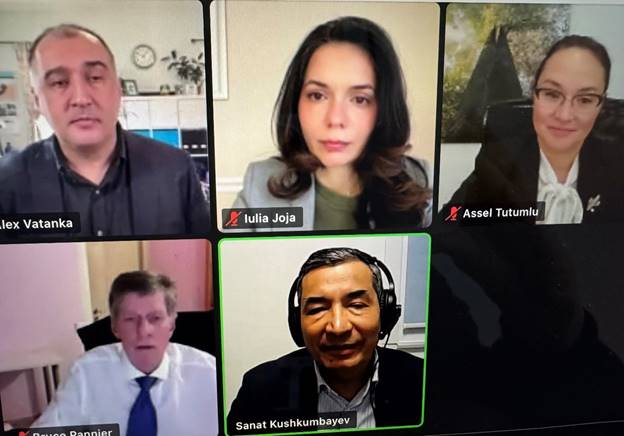
Top row, left to right: Alex Vatanka, Lulia-Sabina Joja, and Assel Tutumlu. Bottom row: Bruce Pannier (left), and Sanat Kushkumbayev (right)
Middle East Institute Explores Geopolitical Implications of Closer Ties between Central Asia and the Middle East
By Elaine Pasquini

Washington: On December 5, 2024, the Middle East Institute (MEI) hosted a webinar on the growing relationship between the countries of Central Asia and the Middle East. The five countries, Uzbekistan, Kazakhstan, Tajikistan, Kyrgyzstan and Turkmenistan, with a collective population of roughly 80 million, represent a significant market in the region. In addition, bordering China, Iran, Afghanistan and Russia make these former Soviet states of extreme geopolitical importance.
Moderator Alex Vatanka, director of the Iran program at the MEI, noted that expanded bilateral and multilateral relations are emerging in various fields through energy cooperation, new transit corridors, trade agreements, and cooperation around security issues.
“For the landlocked Central Asian countries greater economic productivity with the Middle East makes plenty of sense,” Vatanka said. “It gives the region a new important outlet.” He noted, however, that with these opportunities come challenges, one of which relates to Iran, a country that is essentially the geographic bridge between Central Asia and the Middle East and is currently under US-imposed economic sanctions.
Sanat Kushkumbayev, chief research fellow at the Astana-based Kazakhstan Institute for Strategic Studies, addressed the closer economic cooperation between the region and the Gulf states.
For example, the United Arab Emirates has invested over $2.6 billion in Kazakhstan and signed additional agreements worth $900 million. “Kazakhstan sees an opportunity to boost exports to the Gulf, especially wheat and flour,” he said, noting the country’s main export to Afghanistan is wheat.
Central Asia and the Gulf Cooperation Council states are focused on cooperation in the renewal energy, hydropower and agriculture sectors, he added. Many investment projects in these areas have been initiated and are ongoing. But, according to Kushkumbayev, trade relations between Central Asia and the Gulf remain limited with moderate prospects for significant growth.
One major hindrance to trade is the region’s underdeveloped transportation structure. “Investment remains a key priority for Central Asia in building transport infrastructure between our regions,” he explained. Uzbekistan, however, has secured $12 billion in investment deals for the foreseeable future.
“An independent stable Central Asia that maintains a balance in relations with its powerful neighbors China and Russia is in the interests of the United States,” he said. And given Central Asia’s geopolitical and economic context, the region needs its own division within the US State Department, the Kazakh scholar opined.
Assel Tutumlu, associate professor at the Near East University in North Cyprus, explained that transporting goods out of the Central Asian region became difficult following the Russian invasion of Ukraine. Transportation corridors that were responsible for 80 percent of the goods from Kazakhstan as well as the Caspian pipeline consortium that was also responsible for 80 percent of oil basically came under a huge strain with the sanctions.
Since Kazakhstan’s oil came through Russian pipelines many buyers preferred not to engage to avoid sanctions. Businesses lost sizeable revenues due to the war and sanctions. “It was a huge dent,” she said.
Now, the northern corridor is scrutinized because of the sanctions. In the south, where there is not only a difficult terrain but the unrecognized government in Afghanistan, as well as Iran, which is also facing its own sanctions, transportation is difficult. “So, the middle corridor becomes the headway of trying to get the goods out of the region in some fashion,” she said. “It is a real problem to try and connect several countries together…and creating new infrastructural points is difficult particularly pertaining to the Caspian Sea.”
“Because the situation is urgent and a lot of money is necessary upfront for these projects, countries from the Gulf, for example, become really important,” Tutumlu continued. “Gulf countries do not necessarily bring their own political things into the agenda. It is all basically about making business and doing business together.”
With respect to the United States’ role in the region, Tutumlu suggested Washington should “listen to the interests of the Central Asian countries as a region rather than have their own idea about what the region is supposed to be… and generally be engaged with people in Central Asia.”
Julia-Sabina Joja, director of MEI’s Black Sea program, explained that the European Union has a more active policy for Central Asia than the United States.
“When it comes to the United States, the interests are not as much there as they are for the European Union,” she said. Having invested over $100 billion in Central Asia over the past decade, which represents 40 percent of the foreign direct investment in the region, makes the EU the largest foreign investor in Central Asia. “And it is unmatched by the United States,” she said.
Transportation connectivity is of special importance, along with energy cooperation and development. There has been a significant investment by the EU in the important trans-Caspian transport corridor.
Central Asia’s vast energy resources and critical raw materials make the region of high value to the European Union, China, and the United States.
Bruce Pannier, a Central Asia fellow at the Foreign Policy Research Institute, pointed out that there is a natural attraction between Central Asia and Gulf and Middle Eastern countries.
Although the Central Asian states came out of secular Russia, the cities located along the ancient Silk Road are as important to Islamic culture as cities like Mecca or Cairo and make the region an integral part of the Islamic world, he noted.
“So, there was always that connection,” Pannier said. “Now the Arabs see an opportunity with shifting geopolitical positions to reconnect with people they were connected with for hundreds of years, to re-establish the trade routes that had faded away.”
(Elaine Pasquini is a freelance journalist. Her reports appear in the Washington Report on Middle East Affairs and Nuze.Ink.)

